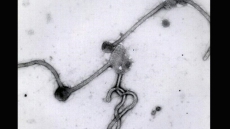OTTAWA — When most Canadians contemplate their national flag, their thoughts might naturally turn to Canada Day, July 1.
Historians and others may think about Feb. 15, the day in 1965 when the modern Canadian flag — bearing its familiar hallmark symbol, the Maple Leaf — was first raised on Parliament Hill.
For Joan O’Malley, Nov. 6, 1964, will forever be the birthday of Canada's iconic red-and-white banner, the day her father asked her to do an impromptu sewing job that she will never forget.
"For me, it's my 50th anniversary," O'Malley told a small gathering of friends, family and political dignitaries Friday on Parliament Hill, where she was presented with the flag that flew from the Peace Tower on Nov. 6 this year.
With her original Singer sewing machine on display, O'Malley described the night her father approached her to ask whether she could sew the three prototypes that had been chosen as the finalists to become Canada's new emblem.
A November snowstorm had fallen over the nation's capital and O'Malley was just home from work with her husband Brian and expecting to spend the evening indoors.
But O'Malley's father Ken Donovan, an assistant purchasing director with the Canadian Government Exhibition Commission, called his then-20-year-old daughter with an urgent request.
That afternoon, Lester B. Pearson had asked that the three flag prototypes that were under consideration be delivered to 24 Sussex Drive so he could see them hoisted on polls at the prime minister's Harrington Lake retreat the next day.
Pearson had come to office with a minority government under a promise made in 1963 that under his leadership, Canada would have a new flag. The final three designs had been picked from a list of entries that totalled more than 3,500.
Pearson's preference was a flag with three red maple leaves on a white background and blue on either side, a design that became known as the Pearson Pennant.
But O'Malley said she knew her favourite right away as she saw the prototypes sprawled across a makeshift table of plywood on top of two saw horses.
"I remember when they first put our flag on my sewing table, I said, 'That's the one that would get my vote,'" she said.
"It was nice, clean looking."
The flag she liked most was, in fact, one designed by historian George Stanley and submitted at the last minute.
The debate over which emblem to choose was a raucous one, pitting Pearson and his design against the Conservatives.
In the end, Pearson's Liberals voted unanimously with the Conservatives in favour of Stanley's now-familiar red-and-white design.
At the time, O'Malley didn't give much thought to the significance of what she was sewing.
"I didn't think it was history in the making at all," she said. "I just knew that they had to have it done and I needed to help my dad out."
Democratic Reform Minister Pierre Poilievre said he's not yet sure where O'Malley's now famous sewing machine will be put on display, but promised that it would be retained by the federal government as a historical artifact.
"It will be preserved as a national treasure," Poilievre said before presenting O'Malley with the Peace Tower flag.
Unlike Betsy Ross, who was paid to produce flags and, as legend has it, sewed the first American Stars and Stripes banner, O'Malley didn't receive a cent for putting the finishing touches on Canada's original flag.
Receiving recognition for her efforts, 50 years later, was thanks enough, she said.
"Now I think I'm paid in full," O'Malley said tearfully as she received a standing ovation.





